Chamberlin Waterproofs Five-Star Hotel in Houston
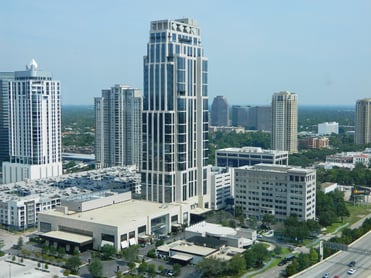 The new five-star hotel developed on West Loop South in Houston, Texas, stands up to the world’s best with attention to detail on every touchpoint and a level of luxury exceeding expectations.
The new five-star hotel developed on West Loop South in Houston, Texas, stands up to the world’s best with attention to detail on every touchpoint and a level of luxury exceeding expectations.
Inspired by existing oak trees on the 10-acre lot, plus a million dollars’ worth of full-grown trees planted on the property, the 38-story hotel tower encompasses 250 ultra-modern guest rooms with floor-to-ceiling windows for sweeping views of the grounds and Houston’s skyline. The mixed-use complex in the city’s Galleria district also features VIP suites, residential suites, a 5,000-square-foot presidential suite, retail and dining, a pool, a luxurious salon and spa, a two-story fitness center and an 11-level parking garage. In addition, it boasts expansive meeting and event space including the largest ballroom in Uptown and the Galleria area plus a 35,000-square-foot conference center. Finally, the destination is home to a two-story Rolls Royce showroom, and an on-property dealership offers one-of-a-kind Bentleys and Bugattis. For the ultimate high-end experience, guests can fly directly from one of Houston's airports to the helicopter pad on top of the hotel.
High-end finishes and furnishings are utilized throughout the development. Upon entering the three-story glass lobby, guests will be mesmerized by a grand chandelier inspired by the Dubai Opera House and custom built in Czechoslovakia. Ebony Woodridge stone pillars, custom Calcutta marble flooring and many spectacular works of art from iconic American artist Frank Stella ensure that quality is of no question.
Due to their working relationship with general contractor Tellepsen, vast waterproofing experience and a reputation for quality work, Chamberlin was selected to install approximately 230,000 square feet and 160,000 linear feet of waterproofing products to seal the entire development. Chamberlin installed vertical below-grade sheet waterproofing and weather barrier on the structure, vehicular traffic coating in the parking garage and pedestrian traffic coating in interior laundry areas. Crews also completed joint sealant installation on the complex’s precast concrete façade, CMU sealants and site and paving sealants. Interior and exterior expansion joints, stone sealants and metal flashing were also included in the scope. A cold-applied waterproofing system was installed on the hotel balconies along with a pedestal paver system. The most intricate application, however, was the traffic coating on the helipad which was designed to look like a nautical compass.
Quality Control
An important part of a quality waterproofing installation is substrate preparation. Chamberlin crews checked all substrates for moisture before installing any products. If a substrate was of an appropriate moisture level, it was then cleaned. Finally, a primer was used on all substrates on this project for enhanced adhesion.
Quality control checks were performed by Chamberlin, the general contractor and the architect. The adhesion and aesthetics of the installations were observed to be of high quality and compliant with project specifications. Chamberlin continuously conducted their own pull tests for the 160,000 linear feet of sealants they installed on a daily basis as the material cured.
Chamberlin had Electric Field Vector Mapping (EFVM) testing conducted on all horizontal waterproofing over occupied space to identify any leaks or problem areas in the membrane. EFVM is an integrity testing technology that isolates problems quickly without damaging membranes or disturbing overburden in the process. Water testing was not scoped or requested, but part of Chamberlin quality control process for this project. The project team was very pleased when they were informed integrity testing would be conducted.
Quality and appearance were major factors in this luxe development and extremely important to the overall outcome of the project. As an additional quality check, Chamberlin’s superintendent created an internal punch list that was completed before the general contractor issued the official project punch list. The project concluded with a beautiful, watertight structure ready to serve on their upscale clientele.
Chamberlin’s objective is to produce quality work, safely, at a competitive price with a spirit of cooperation. Chamberlin’s value “One Time” speaks to the high regard at which Chamberlin holds a quality installation. This value states, “No task is too small or too unimportant not to get it done properly the first time. Whether it’s a takeoff or estimate, correctly reporting your work hours by cost code, approving an invoice or installing material on a project, doing it right one time, the first time, is the basis for delivering successful projects. At Chamberlin we take pride in doing our work one time.”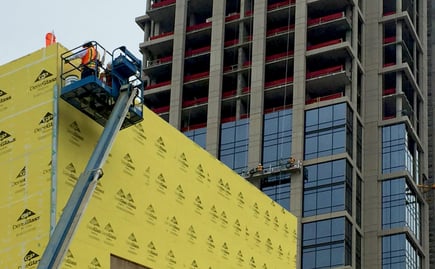
Scheduling
This project was on an extremely aggressive schedule from the start. Nearly 1,000 crew members of multiple trades had to be coordinated to construct this 1,000,000-sqaure-foot development. This means if one trade fell behind, it could cause a domino effect that could potentially affect the entire project schedule. The locations, times and sequencing of each crew had to be carefully coordinated and kept on track.
Chamberlin, the general contractor and the rest of the subcontractors meet weekly for production and scheduling purposes. Chamberlin’s superintendent attended these meetings and was well aware of what was expected of our crews each week. He worked diligently to help the crew meet production. Material ordering, delivery and mobilization took keen attention to detail and proactive thinking.
Open lines of communication were maintained with the general contractor and other trades as necessary. This included careful sequencing coordination with Camarata Masonry, who installed the precast stone. Chamberlin crews followed after them around the building installing joint sealants on the stone panels as they were installed. Chamberlin also worked with the electrician on the exterior lighting. Chamberlin crew members, who were trained to operate the property’s Building Maintenance Unit (BMU) system, provided access for the electrical crew to reach the necessary areas of the hotel tower. Chamberlin also drilled holes in the precast concrete for the electrical cables to run through. Once the cables were in place, Chamberlin waterproofed the penetrations. Chamberlin completed all of their scopes on time contributing to a successful project.
Custom Flashing
The hotel tower design included multiple precast returns where the precast stone runs vertically up the building, turns a 90-degree angle and runs horizontally back to the building. A joint sealant was scoped to waterproof the transition between the vertical and horizontal precast panels. The porous concrete was not scoped to be waterproofed, and the sealant has an average life of about 20 years. This led Chamberlin to suggest a second, more permanent, line of defense against water infiltration. Sheet metal flashing installed underneath the precast at the returns would serve as a pan, catching any water that gets in and diverting it away from the building.
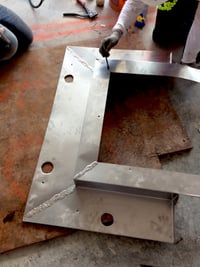 These precast returns came in all shapes and sizes. Some included protrusions, penetrations, cut outs and other variants. Also, due to the construction tolerances for structural concrete building plus the added construction tolerances for precast concrete, there was a wide variation of possible shapes and sizes for each gap that needed to be spanned. To accommodate all of the variations, each flashing transition had to be custom made to match the exact measurements of the space it would be installed. For this challenge, a portable sheet metal break was brought onsite to create the flashings. Experienced Chamberlin sheet metal crew members broke pieces of metal up to ten feet long into custom sizes and soldered the pieces together in various shapes. As they were fabricated, each piece was checked at the installation site for proper fit. If it was not a perfect fit, they were re-fabricated.
These precast returns came in all shapes and sizes. Some included protrusions, penetrations, cut outs and other variants. Also, due to the construction tolerances for structural concrete building plus the added construction tolerances for precast concrete, there was a wide variation of possible shapes and sizes for each gap that needed to be spanned. To accommodate all of the variations, each flashing transition had to be custom made to match the exact measurements of the space it would be installed. For this challenge, a portable sheet metal break was brought onsite to create the flashings. Experienced Chamberlin sheet metal crew members broke pieces of metal up to ten feet long into custom sizes and soldered the pieces together in various shapes. As they were fabricated, each piece was checked at the installation site for proper fit. If it was not a perfect fit, they were re-fabricated.
For each flashing installation, crews laid the metal and stripped it in with a 60-mil peel-and-stick waterproofing membrane. The membrane was then sealed, and a protection board was 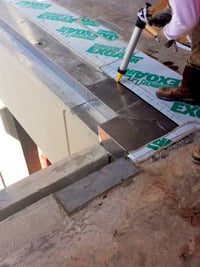 installed. A waterstop was applied to all penetrations before the precast concrete was installed. Finally, Chamberlin crew members caulked the precast panel joint. Hundreds of these sheet metal flashing pieces were created and installed to fit the multitude of precast returns incorporated into the elaborate design of this building. These installations went well beyond normal sheet metal
installed. A waterstop was applied to all penetrations before the precast concrete was installed. Finally, Chamberlin crew members caulked the precast panel joint. Hundreds of these sheet metal flashing pieces were created and installed to fit the multitude of precast returns incorporated into the elaborate design of this building. These installations went well beyond normal sheet metal
flashing requirements. Ongoing coordination meetings between Chamberlin and Tellepsen’s QA/QC managers, supervisors and project management dealt with the unique challenges of addressing these conditions directly behind the precast installer to maintain the construction schedule while insuring a leak-free installation.
Painting the Helipad
One of the most lavish features of this opulent development is the helicopter pad sitting atop the hotel tower. With a private elevator leading directly from the roof to the 5,000 square-foot penthouse, it is the ultimate lap of luxury. Guests can select one-way or round-trip transfers to airports or other destinations in Houston and easily book through the hotel’s own transportation department. Underneath the helipad, the building is topped with steel to help the helicopters land without too much noise or vibration.
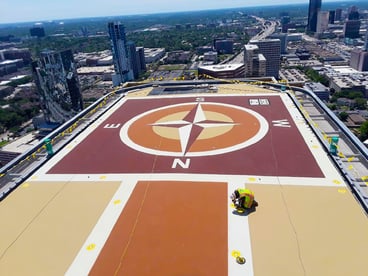 The appearance of this helipad was a peak matter of importance on the job. Any flaws in the installation would not be acceptable. A giant multi-colored nautical compass design was to adorn the helipad. However, instead of paint, this compass was to be created with heavy-duty traffic coating.
The appearance of this helipad was a peak matter of importance on the job. Any flaws in the installation would not be acceptable. A giant multi-colored nautical compass design was to adorn the helipad. However, instead of paint, this compass was to be created with heavy-duty traffic coating.
To begin, Chamberlin crews applied the clear base and mid coating to the entire helipad. Then, GPS surveying was used to draw the outline and details of the compass and indicate the color transitions within the design. Using the survey numbers, Chamberlin crews applied the coating along with a colored quartz aggregate in a ‘paint-by-numbers’ approach. Care was taken to form the correct shapes and keep the colors within the correct lines. The quartz provided slip-resistance and the appropriate color for each section. Crews back rolled the colored quartz into the coating using a refusal method so the quartz was completely encapsulated. Finally, a finishing clear top coat locked the quartz in. The traffic coating on the helicopter pad was finished beautifully and to the satisfaction of the project team. This helipad is a striking symbol of practical waterproofing needs meeting high-finish architectural requirements.
Productivity
This development is not only massive, with nearly a million square feet being constructed simultaneously, but the structure also includes intricate façades. Many situations arose that needed design assistance on the spot, such as the sheet metal flashings utilized to waterproof the precast returns on the hotel tower described above. Chamberlin kept an open line of communication with the general contractor as these conditions were discovered. The Chamberlin project team proposed design options for consideration and implemented the solutions with approval from the general contractor.
To maintain the productivity schedule for this project, Chamberlin had multiple crews working at the same time and clocked over 40,500 total man hours. Different aspects, including weather and other trades’ work, dictated where the crew members could and could not work day to day. Detailed scheduling and pre-planning were necessary to make sure waterproofing crews worked in every accessible location each day to keep all scopes moving forward. For example, one day could have seen three crews caulking the hotel tower while two others applied cold-applied waterproofing over the parking garage, a crew installing expansion joints in the garage and yet two more installing pavers on tower balconies. Chamberlin’s project superintendent and foreman met with all crews daily before work began. They made sure everyone knew what was expected of them, had the proper tools and equipment for the job and reviewed the project’s Job Hazard Analysis. The two supervisors continuously made the rounds throughout the work day monitoring each crew for safety and quality and providing information or mentoring as needed.
The new, elegant development not only brings high-end shopping and dining options to the city, but also a level of luxury and extravagance rarely matched before in Houston, Texas. The first-class hotel will be attractive to high-powered business travelers and swanky vacationers from around the world. Construction of this beauty required extremely high-quality installations, and the aggressive schedule dictated a significant productivity level. Chamberlin delivered their scopes safely, on time and of the highest quality leaving the development watertight for years to come.
Want to see more projects like this?
Subscribe Today!
Stay-in-the-know and subscribe to our blog today!